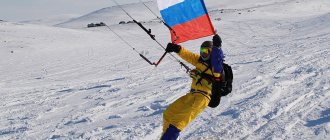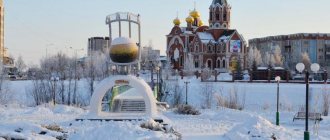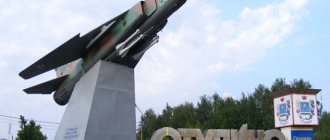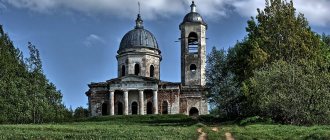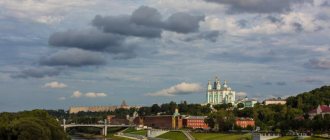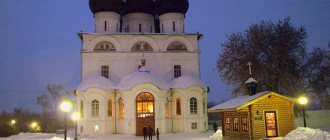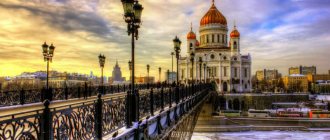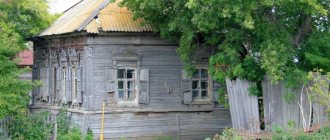The Murmansk region is an unusual region in many ways. Despite the fact that it occupies one peninsula, the variety of landscapes in its different parts is stunning in beauty. Here, endless swamps and high mountain ranges, open tundra and taiga forests coexist; on the seashore, sandy beaches turn into massifs of inaccessible rocks.
The Kola Peninsula of the Murmansk region is a paradise for geologists who can find here many varieties of ornamental stones and rocks. Ethnography lovers will be interested in the villages of the Kola peoples, and those interested in nature will be delighted by the Lapland and Kandalaksha nature reserves.
Church of the Assumption of the Blessed Virgin Mary (Varzuga)
The restored Church of the Blessed Virgin Mary (1674) in the village of Varzuga, Murmansk region, is a remarkable architectural monument, built without a single nail. The Assumption Cathedral is very beautiful and is the ideal creation of a great master. From a distance he seems perfect and surprisingly slender. Its silhouette seems to merge with the surrounding area. Up close, the church looks beautiful, solemn and majestic. The height of the main volume of the cathedral is 13 m, and the rest of the superstructure is 21 m. This size ratio is the “golden ratio of the pyramid”. The roof of the cathedral building has the shape of an equilateral cross.
The beauty of the structure was achieved not only by the slender forms, but also by the external decorative decoration - the presence of many porch columns, beautiful carved details, window casings, lace framing of the lower and upper parts of the dome, patterned ends of the plate roof, barrel ridges and piers. All parts were made of wood of different shades: from dark and red-brown to golden and silver-white. In the sacred place there is a beautiful iconostasis, which includes 84 icons.
The Assumption Church has survived to this day, but not in its original form. Despite some changes, the holy place has not lost its artistic integrity, simplicity, harmony and solemnity. The Assumption Cathedral is the best among the wooden tented monasteries of the north.
“Rafting and fishing along the Indel-Varzuga rivers”
Duration:
6 days/5 nights.
Route:
Kandalaksha - Indel River - Pana River - Varzuga River.
This is a great family holiday in the North. The simplicity of the rivers allows rafting with any level of experience, and the beauty of the Russian North will make rafting unforgettable.
An obligatory part of the rafting trip is licensed fishing for salmon, grayling, and pike. Overnight - in a tent camp.
Explore tour
Museum of Mineralogy and Geology
The museum was created in the 30s. in the city of Apatity, Murmansk region. During the Great Patriotic War, a fire at the station where the building was located destroyed all the collections. In the post-war years, a new, no less valuable collection was created at the Geological Institute.
The museum's collections contain more than 9,000 thousand different samples of ores, minerals and rocks of the Kola Peninsula, most of which are unique and rare. The exposition of the unusual place is presented from: a collection of ores and other minerals, a collection of unusual and beautiful rocks, a systematic collection of minerals, as well as a collection of the latest minerals found in the location of the Kola Peninsula.
Also in this place are collections of igneous, metamorphic and sedimentary rocks, the number of which exceeds 900 specimens. On the territory of the Kola Peninsula there are large deposits of cobalt, apatite, various rare metals, ceramic and high-alumina raw materials, facing and ornamental stones. The museum presents more than 800 representatives of ores and minerals of the Murmansk region.
Lapland Nature Reserve
The Lapland Nature Reserve is located in the western part of the Kola Peninsula near the beautiful Lake Imandra in the Murmansk region. The main value of this beautiful place is its untouched wild nature, which is in its pristine natural state. The area of the Lapland Nature Reserve is 278 thousand hectares - this is the largest protected area in the Murmansk region and Europe.
In these beautiful places, the climate softens the influence of the warm Atlantic Current. The average temperature in the coldest month (February) is about -130C. The white night season in the Murmansk region lasts for 100 days, and the polar night lasts 25 days.
The area is rich in animals, here you can find elk, brown bear, wild reindeer, fox, marten, wolf, otter, etc. Among the birds you can see the Lapland chickadee, jock, woodpecker, hawk, white-tailed eagle. The reservoirs are home to 13 species of fish, 6 of which are salmon, reaching a weight of 4 kg. The flora is dominated by pine and spruce forests with birch and aspen forests; the forests contain a wide variety of berry bushes - blueberries, lingonberries, blueberries. In 1995, the management of the beautiful Lapland Nature Reserve approved the project “Fabulous Lapland – The Domain of Father Frost,” whose tower is located on the shores of Chunozero.
Museum of the History of the Kola Sami
The museum was founded in 1962 in the village of Lovozero, Murmansk region. It was founded in 1962 by high school teacher P. P. Yuryev. The exhibits of this place tell about the culture, life and history of the Sami - the indigenous inhabitants of the Kola Peninsula. The northern people still live today in Sweden, Norway and Finland.
Here are models of ancient houses, objects of applied art, everyday life and clothing, a diorama with a reindeer team, and tools. Also in this place you can see a pyrt or tupa - a dwelling where the Sami lived in the winter; kuvaksu - portable tent, vezhu - at home in fishing grounds.
The museums display archaeological finds from various time periods. Also in this historical place there is an unusual stone with beautiful rock paintings, brought in 1988 from the city of Chalmny-Varre. Large exhibits are ideally complemented by photographs, documents and reproductions from different eras. The museum introduces its visitors to the development of the region from ancient times to the present day.
Hearths of civilization
The largest city on the Kola Peninsula is Murmansk. Few people know that before the revolution it was called Romanov-on-Murman. It is still the largest city in the world located beyond the Arctic Circle. It is also the largest Russian port. The city is quite young in age - it appeared on maps in 1916.
Murmansk
Next in terms of population is the city of Apatity. He also appeared at the beginning of the last century and at first bore the name White. This was due to the fact that it was founded on the banks of the Belaya River. Today it is the world's fifth largest city above the Arctic Circle. The reason for its birth was the discovery of the largest deposit of apatite-nepheline ores. The enrichment plant became the engine of the city's economy.
Severomorsk is slightly behind Apatit in terms of the number of inhabitants. But today it is the main naval base of the Russian Northern Fleet. It was founded in 1896, and until 1951 the settlement bore the name Vaenga. Local residents fished and hunted. The military came to the convenient bay in 1934. By the way, singer Elena Vaenga comes from Severomorsk.
Among the cities, it is also worth mentioning Kirovsk, which has recently become a popular Russian ski center. Like Apatity, it appeared due to the discovery of nepheline ore deposits. A mine and processing plant were built here. Currently, there are three ski slopes within the city. For some reason, Kirovsk is very popular among filmmakers - 28 films were shot in the city, including “Evenings on a Farm near Dikanka” and “Leviathan.” He was even nicknamed Polar Hollywood.
Waterfall on the Chapoma River
The beautiful waterfall is a state hydrological natural monument of the Murmansk region. This is the largest waterfall in the Murmansk region. An amazing place is located in the southeast of the Kola Peninsula on the Chapoma River, 8 km north of the mouth.
Chapoma waterfall consists of 4 rapids, the highest is at an altitude of 20 m. The current of Chapoma in this place is very fast and stormy. Rocks rise majestically above the banks of the river, forming a picturesque canyon. Over the course of 1.5 km, the waterfall forms a height difference of more than 29 m.
The vegetation near the waterfall is represented by beautiful taiga forests with many epiphytic lichens, as well as a developed moss and herb-shrub layer. The most common in these places are forest geranium, horsetail, hellebore, cloudberry, as well as a rare plant listed in the regional Red Book - Maryin Root.
Only here
Local man-made attractions include the bridge across the Kola Bay and the nuclear icebreaker "Lenin", which is permanently moored in Murmansk. The Russian book of records includes the “Snow Village”, which is recreated anew every winter and is an unusual structure with halls, tunnels, furniture and sculptures built from snow and ice.
Not far from Kandalaksha there is a stone labyrinth “Babylon” - one of the mysterious structures of ancient times. Near the mouth of the Varzuga River there is Cape Korabl, in the vicinity of which lies the Kuzomen desert. The Beautiful Waterfall in the Khibiny Mountains fully lives up to its name. There is a good oceanarium in Murmansk.
Among the exotic activities worth noting is diving in the Barents Sea. Despite its extreme northern location, the underwater world is quite rich. Against the backdrop of steep cliffs, you can see scallops, crabs, luxurious sea anemones and a divers dream - the remains of sunken ships. You won't be bored on the Kola Peninsula.
But the most striking, in the truest sense of the word, natural attraction can be considered the northern lights. The night sky is filled with flaming ribbons, arcs and spirals. They can be red, yellow, blue and green. It's hard to believe that this light show is taking place at an altitude of a thousand kilometers above the planet! Natural fireworks displays occur more frequently in spring and autumn than in winter and summer.
Labyrinth
The aurora is so rare and colorful that it is used to attract tourists. Special tours are offered on the Kola Peninsula. True, it is advisable to be lucky. After all, to see the lights, you need a flash of solar activity and cloudless weather. Those who wish are offered to live for several days in tents with a transparent ceiling. In this case, the likelihood of not missing a rare sight increases significantly.
